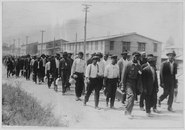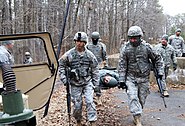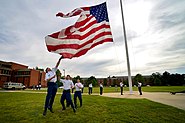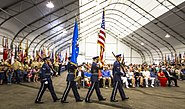| Fort George G. Meade | |
|---|---|
| Near Fort Meade, Maryland in United States | |
 The National Security Agency headquarters building, a major tenant at Fort George G. Meade The National Security Agency headquarters building, a major tenant at Fort George G. Meade | |
 | |
  | |
| Coordinates | 39°6′25″N 76°44′35″W / 39.10694°N 76.74306°W / 39.10694; -76.74306 |
| Type | US Army installation |
| Area | 5,067 acres (2,051 hectares) |
| Site information | |
| Owner | Department of Defense |
| Operator | US Army |
| Controlled by | US Army Installation Management Command (IMCOM) |
| Condition | Operational |
| Website | Official website |
| Site history | |
| Built | 1917 (1917) |
| In use | 1917–present |
| Garrison information | |
| Current commander | Colonel Michael Sapp |
Fort George G. Meade is a United States Army installation located in Maryland, that includes the Defense Information School, the Defense Media Activity, the United States Army Field Band, and the headquarters of United States Cyber Command, the National Security Agency, the Defense Courier Service, Defense Information Systems Agency headquarters, and the U.S. Navy's Cryptologic Warfare Group Six. It is named for George G. Meade, a Union general from the U.S. Civil War, who served as commander of the Army of the Potomac. The fort's smaller census-designated place includes support facilities such as schools, housing, and the offices of the Military Intelligence Civilian Excepted Career Program (MICECP).
| Part of a series on |
| Global surveillance |
|---|
| Disclosures |
| Systems |
| Selected agencies |
| Places |
| Laws |
| Proposed changes |
| Concepts |
| Related topics |
History
For the 1898 Camp Meade at Middletown PA and the "Meadeboro" camp near the Pickett's Charge field, see Harrisburg ANGB and 1913 Gettysburg reunion.
20th century
Initially called Camp Annapolis Junction, the post was opened as "Camp Admiral" in 1917 on 29.7 sq mi (77 km) acquired for a training camp. The post was called Camp Meade Cantonment by 1918, Camp Franklin Signal Corps school was located there and in 1919, the Camp Benning tank school—formed from the World War I Camp Colt and Tobyhanna schools—was transferred to the fort before the Tank Corps was disbanded.
Renamed to Fort Leonard Wood (February 1928 – March 5, 1929), the fort's Experimental Motorized Forces in the summer and fall of 1928 tested vehicles and tactics in expedition convoys (Camp Meade observers had joined the in-progress 1919 Motor Transport Corps convoy). In 1929, the fort's 1st Tank Regiment encamped on the Gettysburg Battlefield.
During World War II, Fort Meade was used as a recruit training post and prisoner of war camp, in addition to a holding center for approximately 384 Japanese, German, and Italian immigrant residents of the U.S. arrested as potential fifth columnists. The Second U.S. Army Headquarters transferred to the post on June 15, 1947; and in 1957, the post became headquarters of the National Security Agency.
Cold War air defense
From the 1950s until the 1970s, the Fort Meade radar station had various radar equipment and control systems for air defense, such as the 1st Martin AN/FSG-I Antiaircraft Defense System. Fort Meade also had the first Nike Ajax surface-to-air missiles in December 1953 (operational May 1954) and an accidental firing occurred in 1955 with Battery C, 36th AAA Missile Battalion. In 1962, the Army's Headquarters and Headquarters Battery, 13th Air Defense Artillery Group, transferred from Meade to Homestead AFB for initial deployment of MIM-23 Hawk missiles, and during the Cuban Missile Crisis, the 6th Battalion (HAWK), 65th Artillery at Fort Meade (a United States Strike Command unit) was deployed to the Miami/Key West area (the 8th Battalion (Hawk) was at the fort in late 1964). Fort Meade bomb disposal experts were dispatched to secure nuclear bombs in the 1964 Savage Mountain B-52 crash.
In 1977, a merger organized the fort's U.S. Army Intelligence Agency as part of the United States Army Intelligence and Security Command. On October 1, 1991, a wing of the Air Force Intelligence Command transferred to Fort Meade, and the organization was replaced by the 70th Operations Group on May 1, 2005. In the early 1990s, 12.7 sq mi (33 km) was transferred from the post to the Patuxent Research Refuge. A planned closure of the post in the 1990s was not implemented, and the Defense Information School moved to the fort in 1995. The 311th Signal Command headquarters was at Fort Meade from 1996 to September 2006.
21st century
The 70th Intelligence Wing headquarters was established at Fort Meade on July 17, 2000, and the Base Realignment and Closure, 2005, designated Fort Meade to gain 5,700 positions. Fort Meade currently has more than 54,000 employees (service members and civilians), and is the largest employer in the state of Maryland and second largest installation by employee population in the Army.
After an August 27, 2007, U.S. Environmental Protection Agency order to assess the contamination at 14 hazardous waste sites on Fort Meade, such as an ordnance disposal area, 1940s waste dump, closed sanitary landfill, a September 2007 environmental impact report identified adding two golf courses would be a "significant threat to the biological and territorial integrity of the Patuxent Research Refuge". The US Army responded that it is "taking steps to limit the environmental damage."
Defense Information Systems Agency
After United States Cyber Command was established at the post in 2009; on April 15, 2011, the Defense Information Systems Agency ribbon-cutting for the move from Arlington County, Virginia, was at the agency's Fort Meade complex of 95 acres (38 ha).
Defense Information School
Further information: Defense Information SchoolThe consolidation of the Defense Information School and the Defense Visual Information School in fiscal 1996 and further consolidation with the Defense Photography School in fiscal 1998 created a single focal point in the Department of Defense for these specialties fields. Advancements in information technology and recent base realignment and closure initiatives have contributed to the evolution of the school. The result is a single school proud of its historical roots and dedicated to serving the diverse requirements for public affairs, broadcasting and visual information.
Security incidents
Alleged gunman Hong Young was arrested in connection with shootings at five public places in Maryland, including an NSA building, theaters and occupied vehicles in late February 2015. No motive has been established but his estranged wife attributed his behavior to mental issues, and he told police he heard voices telling him to shoot at a random driver.
On March 30, 2015, National Security Agency police officers shot and killed a person who attempted to drive an SUV through a restricted entrance to the NSA campus in Fort Meade, Maryland. A passenger in the SUV was injured, as was an officer, and both were treated at a hospital. President Obama was briefed but the FBI determined "we do not believe it is related to terrorism."
On February 14, 2018, National Security Agency police officers shot and wounded an individual who rammed an SUV into a barricade near an entry gate outside of the facility. In the immediate aftermath of the event, the NSA announced that there was "no ongoing security or safety threat."
Geography
Fort Meade is bordered by the Baltimore–Washington Parkway on the west and is about 5 miles (8.0 km) east of Interstate 95. It is located between Washington, D.C., and Baltimore. It is located in proximity to Odenton, Columbia, Jessup, Hanover, Laurel, and Severn.
Based units
Notable military and government units based at Fort George G. Meade.
United States ArmyUnited States Army Civil Affairs & Psychological Operations Command (Airborne)
United States Army Corps of Engineers
United States Army Criminal Investigation Command
United States Army Forces Command
United States Army Intelligence & Security Command
United States Army Recruiting Command
United States Army Training and Doctrine Command Other
United States MarinesMarine Corps Forces Cyberspace Command
Marine Corps Information Command
|
United States Air Force
United States NavyUnited States Fleet Cyber Command (United States Tenth Fleet)
Department of DefenseDefense Counterintelligence and Security Agency
Defense Information Systems Agency
United States Transportation Command
United States Department of the NavyNaval Criminal Investigative Service United States Environmental Protection Agency
Library of Congress
National Security Agency
|
Library of Congress
Fort Meade is used as a storage facility for the United States Library of Congress.
In 1994, a 100 acres (40 ha) site located in the U.S. Army Base at Fort Meade, MD was transferred to the U.S. Congress to provide additional storage capacity for the Library of Congress and other legislative bodies. The current master plan includes the land to construct up to 13 Phased Storage Modules for collections, if this number is needed.
In subsequent years, Congress provided construction funds in the Architect of the Capitol budget for Module 1, completed in 2002, for Module 2, completed in 2005 and Modules 3 and 4 and four cold storage rooms, completed in 2009. A full-scale three-year transfer program of the special format collections to Modules 3 and 4 and the four cold storage rooms began in Spring 2010 and was completed in September 2012. Module 5 has been fully funded with occupancy scheduled for September 2017.
The state-of-the art storage modules are being built to store, preserve and protect the library's collections. Collections include books and bound periodicals as well as special format collections, such as maps, manuscripts, prints, photographs, sheet music, and microfilm masters. If needed and constructed, the 13 collections storage modules will provide a total of 180,600 gross sq ft of archival storage space for the library's collections.
Museums
For the NSA-related museum outside of this post, see National Cryptologic Museum. Not to be confused with the Old Fort Meade Museum at Fort Meade in South Dakota.The Fort George G. Meade Museum exhibited the post's historical artifacts, including uniforms, insignia, and equipment. The museum also had a small collection of vehicles, including a Renault FT, a MK VIII Liberty Tank, an M3A1 Stuart, an M4A3E8 Sherman, an M41 Walker Bulldog, an M47 Patton, armored personnel carriers such as an M113, M114, M84, a Nike Ajax missile, and a UH-1H helicopter. The Fort George G. Meade Community Council noted in July 2018 that the museum would close, with artifacts relocated to the National Museum of the United States Army under construction in Fort Belvoir, Virginia.
Transportation
Since 2005, the NSA operates a shuttle service from the Odenton station of MARC to its Visitor Control Center at Fort Meade. In 2009, the U.S. Army established a similar shuttle service from the Odenton station to the Army section of Fort Meade; the NSA operates this service, allowing garrison employees, persons with Fort Meade visitor passes, and U.S. Department of Defense IDs to board.
Housing concerns
In February 2019, Secretary of the Army Mark Esper, Chief of Staff Mark Milley, and Sgt. Maj. of the Army Daniel A. Dailey met with the commander of IMCOM, the Fort Meade garrison commander, and Army families over safety concerns with housing units on the base in which residents were exposed to lead and asbestos. After speaking with the CEO for the company which manages the house maintenance of the installation, the senior leaders of the Army will determine necessary actions. "We are deeply troubled by the recent reports highlighting the deficient conditions in some of our family housing. It is unacceptable for our families who sacrifice so much to have to endure these hardships in their own homes."—Secretary of the Army, Mark T. Esper and Chief of Staff of the Army, Gen. Mark A. Milley
Gallery
-
 New recruits arrive, circa 1917–1919
New recruits arrive, circa 1917–1919
-
 Inspection of personnel, circa 1930–1945
Inspection of personnel, circa 1930–1945
-
 Medical situational training exercise, 2014
Medical situational training exercise, 2014
-
 Nike missile on display at Fort Meade
Nike missile on display at Fort Meade
-
 Army soldiers from the Defense Information School lower the flag, 2014
Army soldiers from the Defense Information School lower the flag, 2014
-
 Air Force Color Guard march during Massing of the Colors, 2015
Air Force Color Guard march during Massing of the Colors, 2015
-
Officer housing at Fort Meade
See also
References
- "Fort George G. Meade (2512196)". Geographic Names Information System. United States Geological Survey, United States Department of the Interior. Retrieved 2011-09-02.
- "CWG-6". public.navy.mil. 9 June 2017. Retrieved 20 February 2019.
- "To Abandon Camp Meade". Gettysburg Compiler via Google News Archive. October 4, 1898. Retrieved 2011-03-17.
It is stated from Washington that the war department has decided to abandon Camp Meade at once.
(list of articles) - Supplemental History of Construction at Camp Meade, Including Completion Report of Camp Franklin Signal Corps school.http://www.ftmeade.army.mil/museum/archives/Arch. Admiral, MD: February 1919. Weiss, Dreyfous and Seiferth Office Records, Southeastern Architectural Archive, Special Collections Division, Tulane University Libraries.
- Rockenbach, Samuel D (October 13, 1919). Report of the Director of the Tank Corps for the year ending June 30, 1919. Congressional serial set, Issue 7688 (Report). Retrieved 2011-01-17.
- "Gen. Leonard Wood Memorial Authorized By Chief of Staff" (Google News Archive). The Telegraph-Herald and Times-Journal. February 19, 1928. Retrieved 2011-09-02.
- ^ "Fort Meade history". Fort Meade. Archived from the original on 2011-11-11. Retrieved 2011-09-03.
- "1930 Reports". Gdg.org. Retrieved 2012-09-04.
- "NSA/CSS Timeline - 1950s - NSA.gov". NSA.gov. Retrieved 2017-10-14.
- A Handbook of Aerospace Defense Organization 1946–1980, by Lloyd H. Cornett and Mildred W. Johnson, Office of History, Aerospace Defense Center, Peterson Air Force Base, Colorado
- United States Army Air Defense School (1965). "USAADS Digest 1965, Chapter 2: Air Defense Doctrine And Procedures" (PDF). Ed Thelen's Nike Missile Web Site. Ed Thelen.
- Jerry Wilkinson. "North Key Largo Missile Site". Keyshistory.org. Retrieved 2012-09-04.
- "UFO Report". Nicap.org. 1964-12-19. Retrieved 2012-09-04.
- "Inside 70th ISR Wing". 70th ISR Wing. 70ISRW.AF.mil. Retrieved 2011-09-05.
- ^ Fort George G. Meade: Current Site Information, Environmental Protection Agency, retrieved January 24, 2008
- "DINFOS History". Dinfos.osd.mil. Archived from the original on 2012-09-13. Retrieved 2012-09-04.
- Larry Whitley, , Ft. Meade Soundoff, February 14, 2018. Fort Meade is currently undergoing another major transformation and is expecting another 8,000-10,000 employees by 2023.
- Steve Vogel, "U.S. Agency Assails Ft. Meade Plan: Impact Report Cites Concerns About Traffic and Environment, Washington Post, September 22, 2007
- ^ "Ribbon Cutting Celebration..." DISA.mil. April 2011. Retrieved 2011-09-03.
- Myers, Amanda Lee (March 6, 2015). "Hong Young's Estranged Wife Said He Acted 'Crazy' Before NSA Building Shooting". The Huffington Post. Associated Press. Archived from the original on April 3, 2015. Retrieved March 30, 2015.
- Schaffer, Christian (March 31, 2015). "Transgender woman who was shot dead trying to ram SUV through NSA gate was a 'homeless prostitute who was facing prison time". ABC News. Archived from the original on April 5, 2015.
- White, Brian (February 14, 2018). "Suspect wounded, SUV stopped after shooting at NSA gate". MSN. Associated Press. Retrieved February 14, 2018.
- "About Fort Meade, Maryland". FtMeade.Army.mil. Archived from the original on 2013-06-01. Retrieved 2011-09-03. ()
- "Partner Commands". Ford George G. Meade. US Army.
- "Wing Fact Sheet 655th ISRW" (PDF). 2019-04-10. Archived (PDF) from the original on 2021-08-28. Retrieved 2022-03-10.
- "Managing the Collections: Fort Meade Update". Library of Congress. October 10, 2015. Retrieved May 22, 2017.
- "Fort George G. Meade Museum – Home Page". Ftmeade.army.mil. 2008-06-02. Retrieved 2012-09-04.
- "Due Outs" (PDF). Fort George G. Meade Community Council. July 2018. p. 2. Retrieved October 31, 2019.
- McCombs, Alan J. (2009-02-23). "Fort Meade launches commuter shuttle service". United States Army. Retrieved 2017-06-25.
- ^ "Army senior leaders meet with Fort Meade residents, Soldiers and housing staff". U.S. Army. February 14, 2019. Retrieved February 16, 2019.
- "US Army statement on military housing". U.S. Army. February 13, 2019. Retrieved February 16, 2019.
External links
Portal:| United States Air Force | |||||||||||
|---|---|---|---|---|---|---|---|---|---|---|---|
| Leadership |  | ||||||||||
| Structure |
| ||||||||||
| Personnel and training | |||||||||||
| Uniforms and equipment | |||||||||||
| History and traditions |
| ||||||||||
| Air Forces |  | ||||||||
|---|---|---|---|---|---|---|---|---|---|
| Centers | |||||||||
| Bases | |||||||||
| Wings |
| ||||||||
| Army |
|  | |||||||||||
|---|---|---|---|---|---|---|---|---|---|---|---|---|---|
| Air Force |
| ||||||||||||
| Navy |
| ||||||||||||
| National Guard |
| ||||||||||||
| Coast Guard |
| ||||||||||||
| National Security Agency | ||
|---|---|---|
| Locations |
|  |
| Leaders | ||
| Divisions | ||
| Technology | ||
| Controversy | ||
| Programs | ||
| Databases | ||
| Other | ||
- 1917 establishments in Maryland
- Buildings and structures in Anne Arundel County, Maryland
- Forts in Maryland
- Military Superfund sites
- National Security Agency facilities
- Superfund sites in Maryland
- United States Army posts
- World War II prisoner-of-war camps in the United States
- Intelligence agency headquarters in the United States
